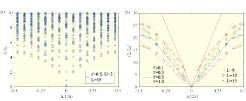Entanglement Spectra between Coupled Tomonaga-Luttinger Liquids
R. Lundgren, Y. Fuji, and S. Furukawa
Quantum entanglement has emerged as a new tool to characterize quantum phases. While the entanglement is nothing but “quantum correlation” that has been a central issue in condensed matter physics for a long time, new quantitative descriptions of the entanglement stimulated by quantum information theory have proved useful. The most frequently used quantity to describe the entanglement in quantum many-body problem is “entanglement entropy”. However, there are other quantities which can be useful, and entanglement spectrum is one of them. Its relation to the spectrum of physical edge states is conjectured [1], and has been confirmed in several examples.

Fig. 1. The dispersion of entanglement spectra of a spin ladder model when a linear combination of two TL fields remains gapless while the other acquires a gap. The numerically obtained dispersion relation agrees well with the peculiar square-root dependence predicted by the theory.
Here we report on a recent joint research [2] on entanglement spectra between two coupled Tomonaga-Luttinger liquids (TLLs). TLL is a ubiquitous effective field theory for quantum many-body problem in one dimension, and many physical systems such as quantum spin ladders and carbon nanotubes are described as coupled TLLs. There are variety of phases in coupled TLLs. In a class of gapless phases of coupled non-chiral TLLs, we find an entanglement spectrum with a dispersion relation proportional to the square root of the subsystem momentum. This result was derived using the field theory, and was then confirmed numerically for a spin ladder model. Such a dispersion is generally not expected for a spectrum of physical excitations, including those of edge states. We relate the unusual dispersion relation in the entanglement spectrum to a long-range interaction in the entanglement Hamiltonian. Our result sheds new light on the correspondence between the entanglement spectrum and the spectrum of the edge states.
This work was performed during a visit by R. Lundgren, a Ph. D. student at University of Texas, under the NSF East Asia and Pacific Summer Institutes for U.S. Graduate Students and the JSPS Summer Program, hosted by ISSP in cooperation with Department of Physics, the University of Tokyo.
References
- [1] H. Li and F. D. M. Haldane, Phys. Rev. Lett. 101, 010504 (2008).
- [2] R. Lundgren, Y. Fuji, S. Furukawa, and M. Oshikawa, Phys. Rev. B 88, 245137 (2013).
